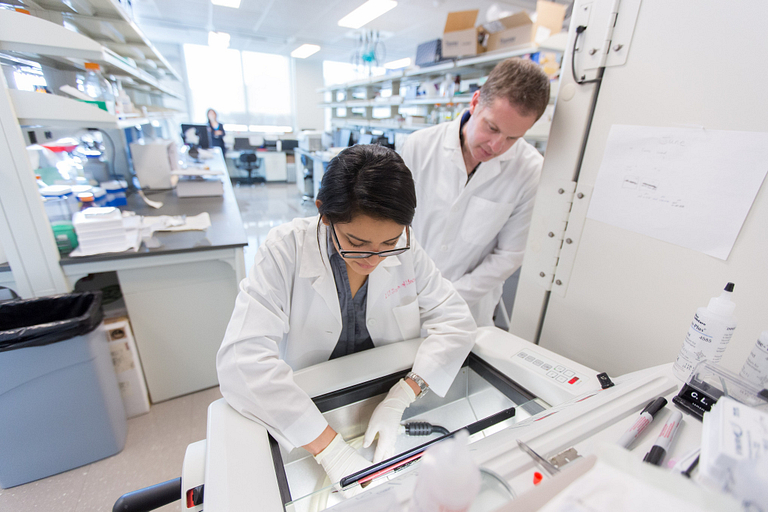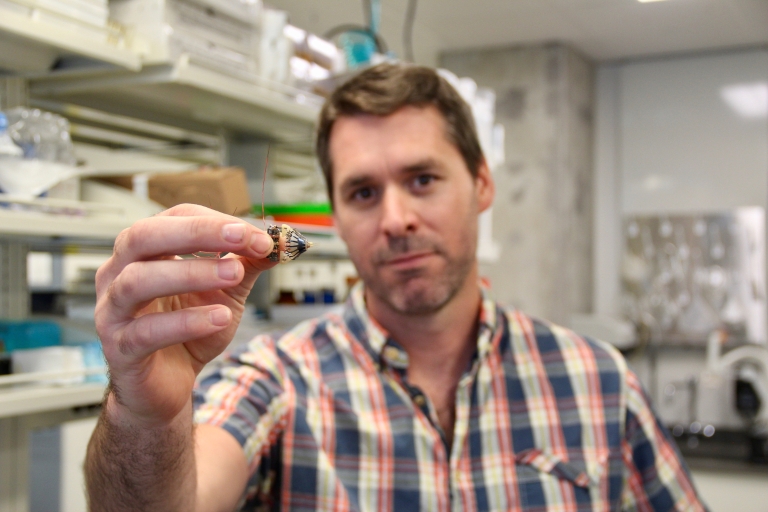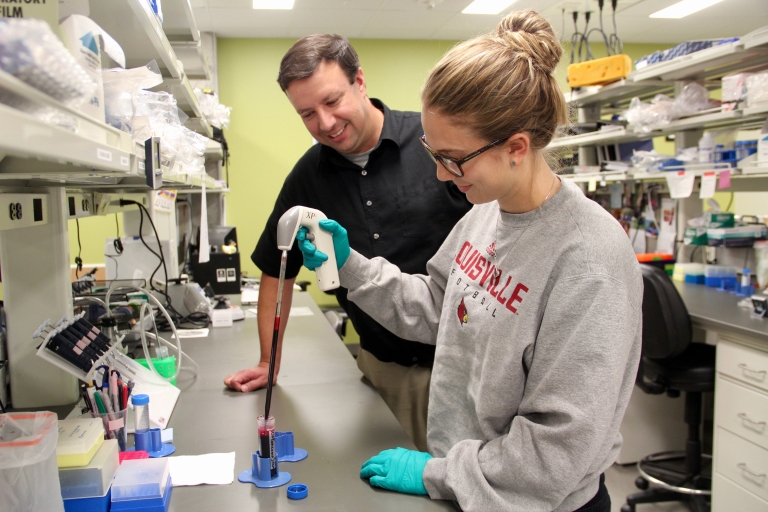
Four years after its opening, it still has that “new building” smell.
The Science and Engineering Laboratory Building, known to many as SELB, opened in the fall of 2013 to much fanfare from two of IUPUI’s essential programs in a STEM world.
The schools of Science and Engineering and Technology at IUPUI had a brand-new, state-of-the-art facility to conduct research at their disposal. On the second floor alone, engineers and scientists from multiple disciplines coexist and collaborate, as their labs are nestled next to one other.
The investigators had a say in the facility’s design. They customized layouts and equipment. They were able to move out of buildings and labs that were starting to show their age. They also brought the bands back together.
Description of the following video:
Video transcript
IUUI Researchers Find Collaborations, Breakthroughs in SELB video on https://youtu.be/1T4GondidpQ
[Video: Exterior and interior shots of SELB]
[Words appear: IUPUI presents]
[Words appear: Christopher Lapish, Psychology, Associate Professor]
Christopher speaks: The front of the building is really beautiful, and it has a wide, huge, open atrium with a veranda kinda over it. And the atrium’s really nice. We’ve had talks in there before, lunches quite often. It provides a space for students to engage in collaborative learning or studying in between classes.
And so those spaces are really needed here on campus, and it meets those needs. When I got here, I found that they involved the scientists and the people that would use the building in the design of the building, which was phenomenal. And so the lab that I’m in right now, many of the features that it has, I got to design, and it’s really been helpful in our ability to perform science.
This is a really nice soldering iron. Here’s some impedance detectors that we use here, pretty standard lab microscope here. We went from a very small, antiquated, old, dusty laboratory, into a state-of-the-art, world-class lab now. I’m really, really excited about that.
[Words appear: Stephen Boehm, Psychology, professor]
Stephen speaks: It was really great when this building opened, first and foremost, because it brought us all back together.
So all the addiction neuroscience faculty are now in the same space. This entire lab that we’re sitting in right now is the main wet lab for the entire addiction neuroscience department. So all the faculty have space in this room or in one of the adjacent small rooms that branch off from this room.
And this is where all our molecular and bench-type assays are done in support of all the behavioral work that occurs up on the third floor of this building. We wanted space that could accommodate the work that the current faculty were doing, addiction neuroscience faculty. But we wanted, also, the space to support some of the basic needs of future hires that we though we might go for.
[Video: The Indiana University trident appears]
[Words appear: IUPUI]
[Words appear: Fulfilling the Promise]
[End of transcript]
“All of the addiction neuroscience faculty are now in the same space,” said Stephen Boehm, professor of psychology and director for the undergraduate neuroscience program, adding how his departmental colleagues were spread across campus before SELB was built. “This entire lab is the main wet lab for the entire program. This is where all of our molecular and bench-type assays occur in support of all the behavioral work that happens on the third floor of this building.”
Boehm shares his lab with associate professor Chris Lapish. They are using rats and mice to study the neurological effects of addiction.
“We’re interested in changes of the mouse brain,” Boehm said. “We have mice in binge alcohol drinking tests that mimic the characteristics of binge drinking in humans. All of the behavioral measures of intoxication are there. We try to understand the behavior first before we move on to the brain and how it changes.”

Lapish revealed smaller labs and offices that adjoin the main lab: a maze room that tests the rats’ cognizance and addiction levels and a computer room where thousands of data points are crunched from each experiment.
The electrodes that attach to the rats’ brains are constructed in the main lab, which is also where the analysis of cellulose membranes takes place.
“You put it in milk,” Lapish said. “All the proteins in the milk attach to the membrane. It prepares the blots for them to use to assess protein concentration of different proteins throughout the brain.”
On the third floor, the rats and mice are cared for next to a skybridge that connects SELB to the Science Building. The bridge provides a majestic view of downtown Indianapolis. On the south side of the building, Military Park is visible and even audible.
“You can actually hear the music from the Lawn at White River if they’re having a concert there,” Lapish said.
When Lapish interviewed with IUPUI in 2010, he was lured by the promise of a new building. IUPUI delivered – and then some.
“They said, ‘We’re going to build this new building, and if you come, you’re going to have a new laboratory,’” Lapish recalled. “I got to design many features of the lab I’m in right now, and it’s really been helpful in our ability to perform science.
“We went from a very small, old, dusty laboratory to a state of the art, world-class lab.”
More than experiments
On the first floor, multiple open spaces enclosed by glass walls and doors are simply labeled “collaboration.” A recent pass saw small groups of students huddled around laptops working on projects. Whiteboards are available for brainstorming and scrawling breakthroughs. Around the corner is a large atrium to promote further interaction among engineering, technology and science minds.
“We’ve had talks in there, and lunches quite often,” Lapish said. “It’s a space for students to engage in collaborative learning or studying between classes. Those spaces are really needed here on campus, and it meets those needs.”
The east side of the building’s exterior pops with colorful windows. The west side helps corral students to the common outdoor areas dubbed the “Science Lawn.” Essentially, it’s a nice fit.
From the bio side
Jason Meyer, associate professor of biology, has a lab around the corner of Lapish and Boehm’s. His work examines human induced pluripotent stem cells for studies of nervous system development and disease. The cells are genetically modified to become any type of cell in the body, and they can serve as a novel platform for studies of neural development, disease progression, drug screening and cellular repopulation.

“What we’re interested in is the ability to differentiate these cells into the different kinds of neurons of the retina, the light-sensing part of the eye that allows us to see,” Meyer explained. “We’re interested in the possible regeneration of the visual system – can we figure out ways to encourage these cells to regrow and perhaps sometime in the future to develop new therapeutic options for blinding disorders.”
The main target for Meyer’s current research is the retinal ganglion cell and its long, branchlike shape. These cells connect our eyes to our brain.
Meyer’s research has had a comfortable home in SELB, whether he is studying cells in a dish from glaucoma patients or developing new drugs that could rescue stop the progression of visual degeneration to restore some degree of vision. Meyer and his students are able to grow fragile lines of stem cells.
“It takes quite a long time to grow these cells,” Meyer said. “To have a dedicated space like this allows us to keep them isolated to keep them away from any kind of contaminants that might damage them or affect their growth.
Collaboration with Meyer’s psychology colleagues is much more of a possibility in SELB than in previous locations, he said.
“To have those kinds of connections with neighboring labs and other researchers in those labs really helps facilitate discussions and helps synergize research,” he said.

